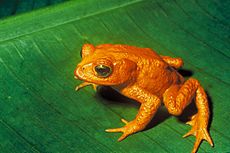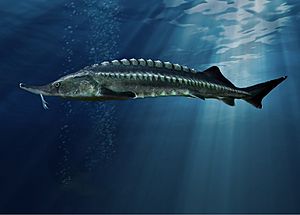Critically Endangered facts for kids
Quick facts for kids Conservation status
|
|
|---|---|
 |
|
| Extinct | |
|
|
| Threatened | |
|
|
| Lower Risk | |
|
|
|
Other categories |
|
|
|
|
Related topics
|
|
 Comparison of Red list classes above and NatureServe status below  |
|
A Critically Endangered (often called CR) species is an animal, plant, or fungus that faces a very high risk of disappearing forever in the wild. This means its population is so low or its habitat is so threatened that it could become extinct very soon.
The International Union for Conservation of Nature (IUCN) keeps a special list called the IUCN Red List. This list tells us how safe different species are. It places species into different groups based on things like how many are left, where they live, and what dangers they face. Critically Endangered is the most serious group for species still found in the wild.
As of 2021, the IUCN tracks over 120,000 species. More than 8,400 of these are considered Critically Endangered. Even if a species hasn't been seen in a long time, the IUCN still lists it as Critically Endangered until they are sure it's gone.
Contents
What Makes a Species Critically Endangered?
For a species to be called Critically Endangered, it must meet at least one of these important rules:
A: Population Drop
- The number of individuals has fallen very quickly.
- This drop is measured over 10 years or three generations of the species.
- If the reasons for the decline can be fixed, the population must have dropped by at least 90%.
- If the reasons cannot be fixed, the population must have dropped by at least 80%.
B: Small Living Area
- The species lives in a very small area, less than 100 square kilometers (about 38 square miles).
- Or, the specific places it lives in add up to less than 10 square kilometers (about 4 square miles).
- Its habitat might be broken up into tiny pieces.
- The quality of its habitat is getting worse.
- The number of places it lives or the number of adult individuals is decreasing.
- The size of its living area or population changes wildly.
C: Very Few Individuals Left
- There are fewer than 250 adult individuals left.
- And either:
- The population has dropped by 25% in 10 years or three generations.
- The population changes a lot, or most of the adults are in one small group.
- Or, no single group has more than 50 adult individuals.
D: Extremely Small Population
- The total number of adult individuals is less than 50. This is a very tiny population.
E: High Chance of Extinction
- There is at least a 50% chance that the species will become extinct in the wild within 10 years or three generations.
Why Do Species Become Critically Endangered?
Many species are becoming extinct much faster than they would naturally. This is mostly because of things humans do, like climate change and losing different kinds of life.
Habitat Loss
The biggest reason species become endangered is habitat loss. Animals and plants need their homes to find food, shelter, and raise their young. When these homes are destroyed, species can't survive.
- Pollution makes habitats dirty and unsafe.
- Urbanization means building cities and towns where wild areas used to be.
- Agriculture turns natural land into farms, taking away space for wildlife.
Invasive Species
Sometimes, new species are brought into an area where they don't naturally belong. These are called invasive species.
- They can take over resources that native species need.
- They might eat the native species or spread diseases.
- This can cause native plants and animals to become endangered or even extinct.
Diseases
Diseases can also threaten species. If a new disease enters a habitat, native species might not have any way to fight it off. This can cause many individuals to die, leading to a big drop in their population.
See also
 In Spanish: Especie en peligro crítico de extinción para niños
In Spanish: Especie en peligro crítico de extinción para niños


